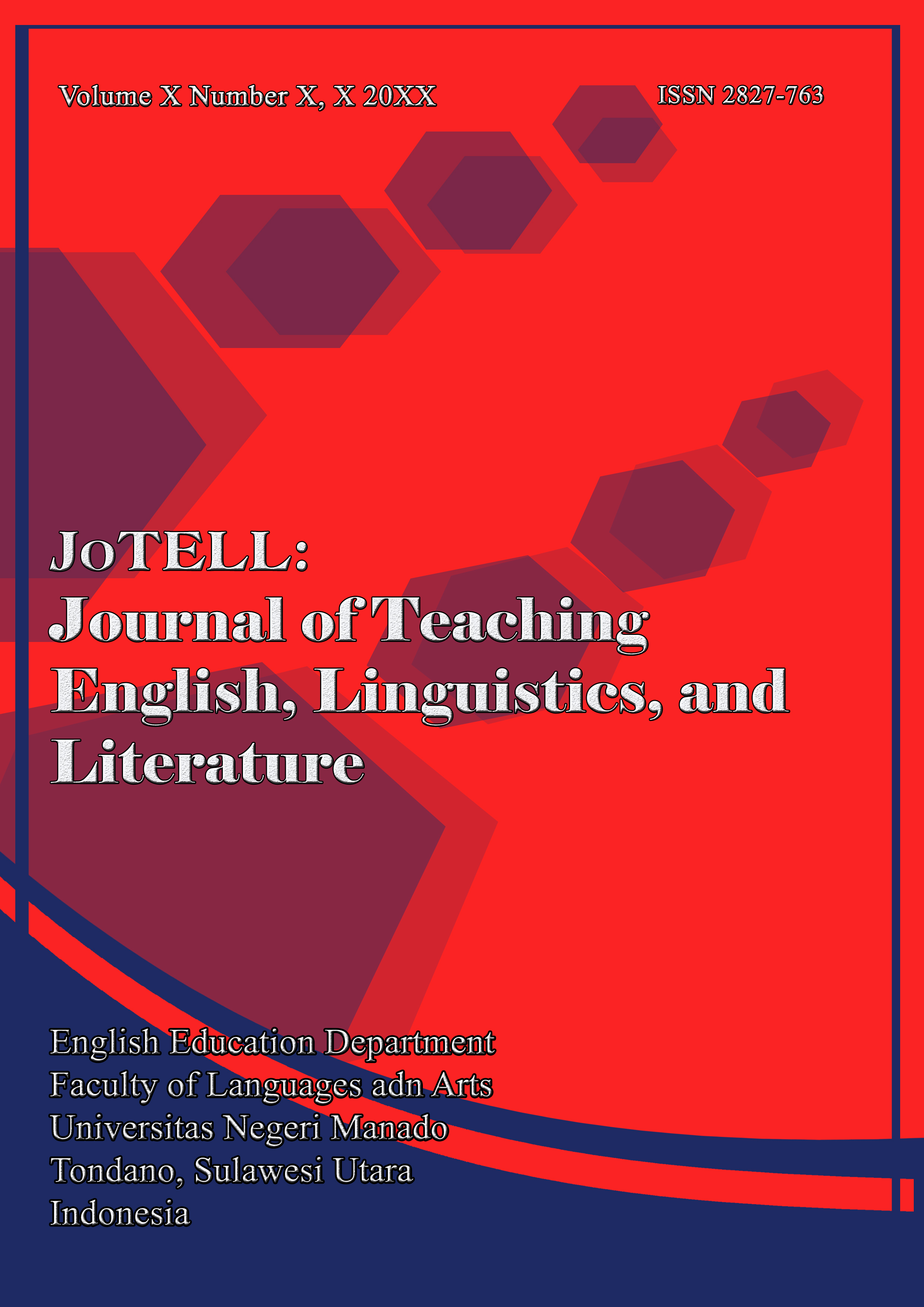THE USE OF CROSSWORD PUZZLE GAME TO IMPROVE STUDENTS’ UNDERSTANDING OF HOMOPHONE
DOI:
https://doi.org/10.36582/jotell.v1i11.5136Abstract
The background of this research was based on students’ difficulties in differentiating meaning and spelling of the words with homophone pair, which means their understanding of homophone were less. This research is intend to see whether Crossword Puzzle Game is effective or not in improving the students’ ability of understanding homophone. In other words, this research was to find out how much the improvement of students’ understanding after being taught using Crossword Puzzle Game. For that reason a strategy must be given to make them learn easily. In this research, Crossword Puzzle Game was used to help students understand homophone words. This study was focused on writing skill, especially on spelling, at the 7th grade of SMP Negeri 5 Manado, specifically class 7.7, in the academic year of 2021/2022. This research discuss about the use of Crossword Puzzle Game to improve students’ understanding of homophone. The implementation of Crossword Puzzle Game in teaching homophone was conducted with pre-test and post-test. The participant of the pre-test was 22 students where the average of students’ score was 63.77, while the participant of post-test was 21 students where the average of students’ score was 81.52. By those results, the increase percentage was calculated and the result showed that the students’ of 7.7 in SMP Negeri 5 Manado, in the academic year of 2021/2022 made an improvement score about 30.70%. From the description above, the conclusion of this study was the use of Crossword Puzzle Game could improve students’ understanding of homophone.
References
Ayeni, A. W. (2014). Empirics of Standard Deviation. Empirics of Standard Deviation, 29 July, 1–8.
Davis, D. F., & Herr, P. M. (2014). From bye to buy: Homophones as a phonological route to priming. Journal of Consumer Research, 40(6), 1063–1077.
Franklin, S., Peat, M., & Lewis, A. (2003). Non-Traditional Interventions to Stimulate Discussion: The Use of Games and Puzzles. Journal of Biological Education, 37(2), 76–82.
Garth, A. (2008). Analysing data using SPSS ( A practical guide for those unfortunate enough to have to actually do it .).
Hampp, P. L. (2019). Use of Songs in Teaching Simple Tobe and Past Tense Teaching. Journal of English Language and Literature Teaching, 4(1), 15–24.
Henrich, R., Molenda, M., & Russel, J. (1982) Instructional Media and the New Technologies of Instruction. Performance & Instruction Journal, 25.
Ismawati, E. (2012). Metode Penelitian Pendidikan Bahasa dan Sastra. Ombak, 73–74.
Kaya, Y. (2013). Comparison of Quantitative and Qualitative Research Traditions: epistemological, theoretical, and methodological differences. European Journal of Education, 48(2), 311–325.
Lengkoan, F., & Rombepajung, P. A. (2022). Teachers' Perception of Online Learning in The Pandemic Era. Jurnal Lingua Idea, 13(1), 1-11.
Liando, N. V., Tatipang, D. P., & Lengkoan, F. (2022). A Study of Translanguaging Practices in an EFL Classroom in Indonesian Context: A Multilingual Concept. Research and Innovation in Language Learning, 5(2), 167-185.
Liando, N. V., & Lumentu, R. (2017). Students’ Personal Initiative towardds Their Speaking Performance. International Education Studies, 10(8), 21–28.
Lind, D. A., Marchal, W. G., & Wathen, S. A. (2007). Teknik-teknik Statisika dalam Bisnis dan Ekonomi Menggunakan Data Global.
Mogea, T. (2019). Enhancing Students’ Speaking Ability Through Small Group Discussion Technique to the First Year of SMA Negeri 1 Ratahan. Journal of Educational Method and Technology, 41.
Olii, S. T., Andries, F., & Gerungan, F. N. (2020). an Analysis of Code Switching in Instagram Captions. 5(01), 61–85.
Rorimpandey, R., Kumajas, T., & Mandang, F. H. (2019). Prefixes in Tontemboan Language. International Joint Conference on Science and Technology (IJCST), 2, 109–116.
Sabiqoh. (2016). Teaching Vocabulary By Using Crossword Puzzle At The Fifth Semester of The Seventh Grade Students of MTS Ma’arif Nadatul Ulama Mataram.
Samola, N., Maru, M. G., & Sudarsono, L. (2018). a Discourse Analysis of Figurative Language in Barrack H. Obama’S Speech. Journal of English Language and Literature Teaching, 1(01), 7–15.
Sugiyono, D. (2010). Metode Penelitian Kuantitatif, Kualitatif, dan Tindakan.
Tatipang, D., Oroh, E. Z., & Liando, N. V. (2021). The Application of Mind Mapping Technique To Increase Students’reading Comprehension at The Seventh Grade of SMP. KOMPETENSI: jurnal Bahasa dan seni, 1(03), 389-397.












